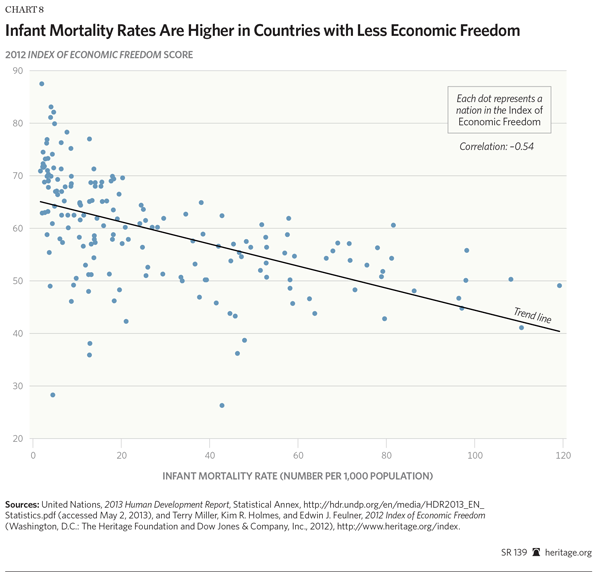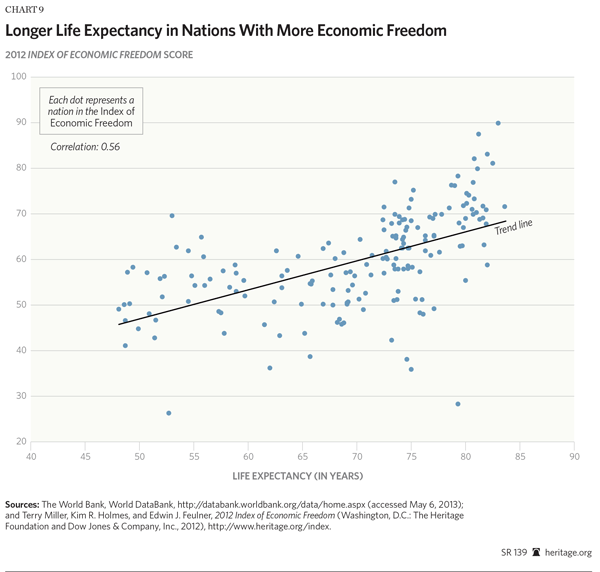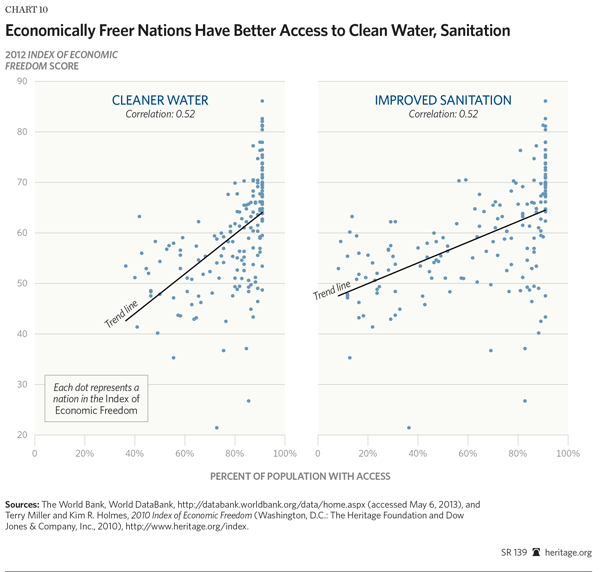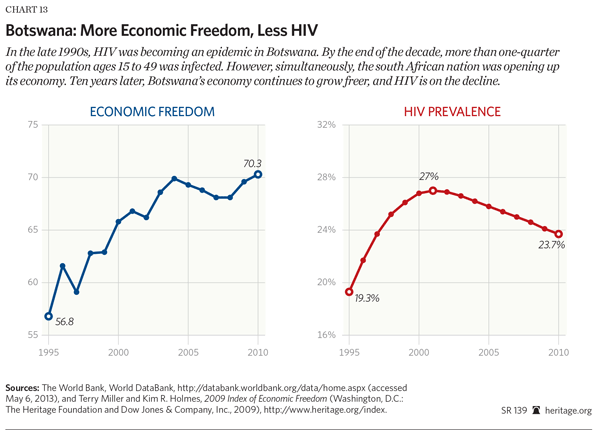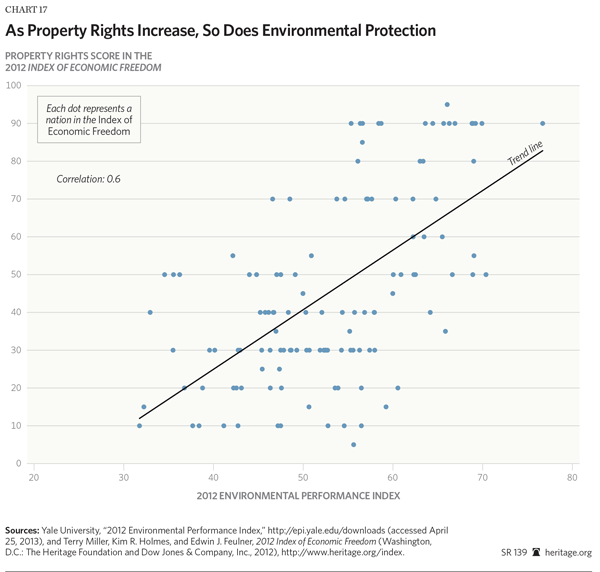Notwithstanding the overwhelming evidence of success over the past two centuries, critics continue to insist that economic freedom has been a failure. A frequent charge is that governments that prioritize policies such as low tax rates, impartial rule of law, strong private property rights, and unfettered access to markets generally fail to provide citizens with adequate health care, education, and clean environments. The results of the Index of Economic Freedom, however, tell quite a different story. In fact, greater economic freedom correlates with better outcomes in schools (both public and private), higher literacy rates, lower infant-mortality rates, longer life expectancy, and a cleaner, safer environment.
Ironically, it is the countries that reject economic freedom that produce inferior social goods. Higher quality social goods are created when consumers have a greater variety of choices—which are created through genuine free-market competition. It is through competition and choice—basic tenets of economic freedom—that countries, especially in the developing world, create the best opportunities to earn a higher quality of life for their citizens.
The authors of this Special Report used cross-country analysis to compare availability of important social goods—education, health, and a clean environment—among countries with high and low levels of economic freedom. As with the Index of Economic Freedom itself, the results outlined in this report provide compelling evidence of the benefits of increasing freedom.
Education
Education enhances people’s efforts to lift themselves out of poverty and earn their own success through hard work and entrepreneurship. Contrary to popular misconception, empirical evidence indicates that the free-market principles that underlie economic freedom are the most effective means of producing these desirable educational outcomes for most people.
Education policies that tend to increase centralization of educational agencies, bureaucratization, and unionization—many of which have held sway in the United States and other developed countries in the past few decades—have led to drastic increases in government spending on education with very little progress to show. These policies are correlated with stagnating scores on standardized tests and other failures. Nevertheless, the Left often derides the economic freedom policies of decentralization, competition, and educational choice. While they might not admit it, progressives by their actions and policies demonstrate a distrust of parents and an attitude that parents should not be permitted to determine where their children go to school, what they learn, or by whom they are taught.
While most can agree on basic standards of literacy and other requirements for an educated citizenry facing the demands and opportunities of the information economy of the 21st century, the reactionary policies of the education “establishment” in government and academia are generating negative educational outcomes. Instead, government policymakers need to take a serious look at policies that embrace economic freedom. Charter schools and voucher programs increase competition in school systems, raising standards and outcomes for students and teachers. Returning educational decisions to parents and local school officials allows educators the opportunity to tailor curricula to the local environment and work force, improving students’ chances of employment. In Sweden, school vouchers have reinvigorated that public school system, allowing children and parents to choose the school that is right for their education. Not surprisingly, Sweden’s economic freedom score has risen consistently over nearly two decades, up nearly 18 percent since 1995.[1]
In a globalized world, students from Ohio are no longer merely competing with students from across the state or the country, but with students from around the world. In order to remain competitive, educational systems need flexibility, competition, and choice—the foundations of economic freedom.
Literacy and Basic Education. One of the most easily recognized indicators of the success of a society’s provision of basic social goods is the literacy of its citizens. Literacy is the foundation for continued success in advanced information-age economies as well as increased educational and economic achievement throughout the lifetimes of its citizens. Those who are less literate cannot access or profit from the near-infinite amount of information now available, and cannot provide a home environment that encourages their children’s educational achievement. Those who are literate are able to navigate government bureaucracies to start a business, secure vital documents, or register for social services. Finally, and most importantly, widespread literacy is a vital requirement for a healthy constitutional democratic republic.
Higher rates of literacy are also prerequisites for economic growth. Literacy improves the human capital within a country, qualifying individuals for jobs that require better training and have higher wages. This subsequently contributes to increased growth. Research has found that “the fastest economic breakthroughs [are] achieved by those countries that [have] already attained sufficiently high levels of literacy.” Correspondingly, high literacy levels have a strong relationship with per capita gross domestic product (GDP), making them a key factor in long-term growth.[2]
These positive outcomes from literacy are consistent with increased levels of economic freedom. According to the 2013 Index of Economic Freedom,[3] published jointly by The Heritage Foundation and The Wall Street Journal, greater economic freedom correlates with higher literacy.[4] As can be observed in Chart 1, countries with higher levels of economic freedom have higher levels of adult literacy as measured by the U.N.’s Human Development Index (HDI).[5] In the sample, countries in the highest quartile of the Index of Economic Freedom on average tend to have 21 more literate adults per 100 than countries in the lowest quartile of economic freedom. On average, only 74 percent of adults in the most economically repressed countries (the second and third quartile) are literate.
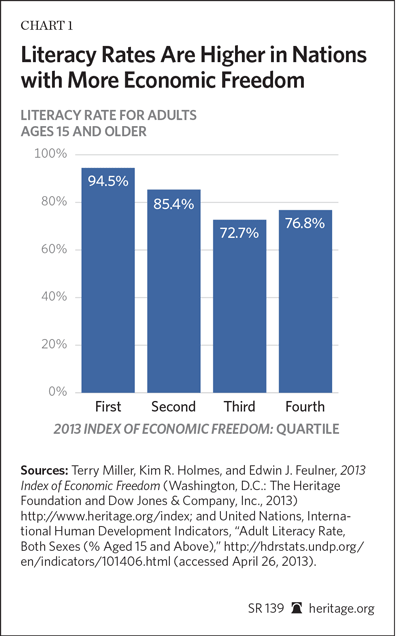
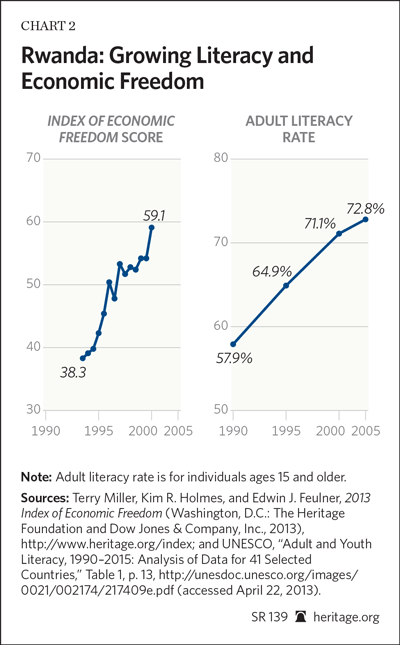
Nowhere in the world is the problem of illiteracy worse than in sub-Saharan Africa. In a 2010 study by the U.N. Educational, Scientific and Cultural Organization (UNESCO), nine of the 20 sub-Saharan African countries studied had literacy rates below 50 percent. In Burkina Faso, the worst case, less than one-third of the population is literate. Thus, it is not surprising that sub-Saharan Africa has the lowest regional score in the 2013 Index of Economic Freedom, at 53.7 (of 100).[6]
However, there is hope—if countries stick to the principles of economic freedom that can lift their populations out of the illiteracy trap. In the 1990s, Rwanda was ravaged by civil war and genocide, which is estimated to have killed between 500,000 and 1 million people. After the violence subsided, the new government, led by President Paul Kagame, initiated a rapid set of reforms that embraced the principles of economic freedom. The result has been not just growth in prosperity, but a marked improvement in literacy. In 1990, at the beginning of the civil war, less than 60 percent of the population could read and write. By 2010, however, literacy had improved to over 70 percent.
This jump was accompanied by remarkable gains in economic freedom. In 1997, the first year that Rwanda was graded in the Index, the country scored a paltry of 38.3. By 2013, Rwanda had scored 64.1, a remarkable 67 percent increase in economic freedom. The U.N. predicts that if current conditions persist, Rwanda will continue to make gains in literacy through 2015, and possibly beyond.[7]
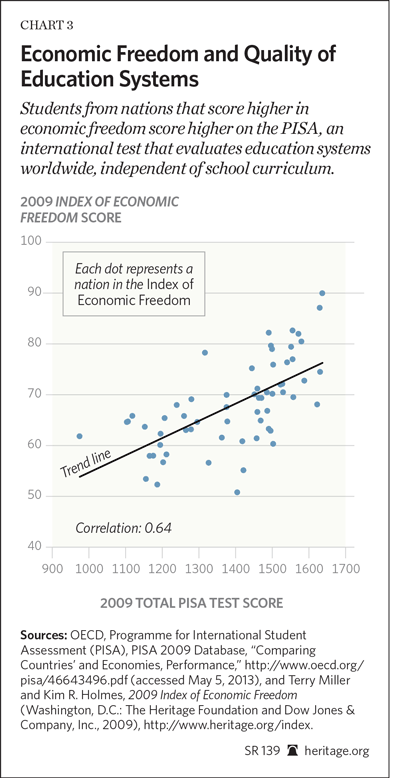
Primary and Secondary Education. While literacy levels are a broad indication of the ability of economic freedom to deliver greater levels of social goods, more specific data provides even better evidence of the positive effects of economic freedom. The Organisation for Economic Co-operation and Development (OECD), funded by the world’s most advanced countries,[8] regularly measures student achievement in dozens of developed and emerging-market countries worldwide through a metric called the Program for International Student Assessment (PISA).[9]
Administered every three years, PISA tests 15-year-old students via unique examinations that cover the basic subjects of math, reading, and science. In 2009, the most recent year available, the OECD tested 15-year-olds in 65 countries. Scores for each country are the mean of all student scores in that country for each category. The top scores in science, reading, and math went to Finland, South Korea, and Singapore, respectively.[10]
By combining each country’s average score in math, science, and reading, an aggregate score can be generated across disciplines. These maximum scores can then be used to compare a country’s overall performance in all the disciplines with each country’s individual score in the Index of Economic Freedom. (See Chart 3.) In this analysis, a fairly robust and positive correlation (r=0.64) emerges. This correlation indicates that countries with higher levels of economic freedom tend to have students that perform better on international tests. The average economic freedom score for the PISA sample countries is 68.2, well into the upper bound of the Index’s “Moderately Free” category. It is also not surprising that students from Hong Kong, the economically freest country in the world according to the Index, achieved the highest overall test scores.
Lifetime Education. Students who live in countries that embrace economic freedom not only score better on international standardized tests, they also tend to stay in school longer. Again, using numbers from the U.N.’s HDI, it is obvious that there is a positive relationship between expected years of schooling and economic freedom. (See Chart 4.) People in countries in the first quartile of the 176-country sample—those with the highest economic freedom scores—tend to obtain more years of schooling than those living in countries in the last quartile (with the lowest scores). Individuals in the first quartile can expect to receive on average 15 years of schooling, while students in the most economically repressed countries, Quartile Four, receive only 11 years of education over their lifetimes. That outcome is also seen in the positive correlation (r=0.54) between countries with high levels of economic freedom and expected years of schooling. This correlation suggests that countries with high levels of economic freedom not only provide better educational opportunities for their students, but also can allow them to remain in full-time educational activities for longer periods of time. Those countries also tend to provide more opportunities for lifelong learning and job re-training.
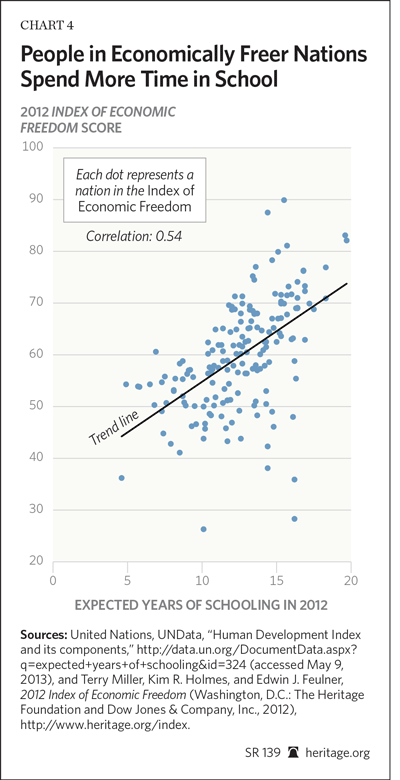
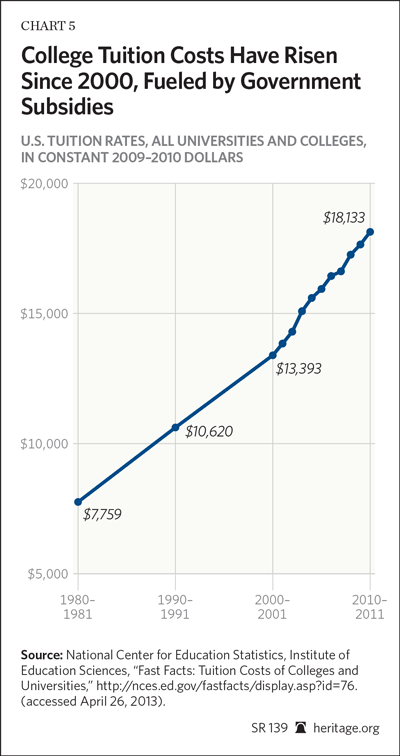
Higher Education. A country’s capacity to provide high-quality primary and secondary educational opportunities is a key component of its future success. For a country to become competitive globally, however, it must have educational facilities and private business enterprises that employ innovative, highly productive people who are able to do cutting-edge research and to develop ground-breaking goods and services. These qualities depend largely on the strength of a country’s institutions of higher learning. In the United States, individuals who earn bachelor’s degrees tend to earn 63 percent more than those with only high school degrees. In addition, the unemployment rate for those with college degrees is more than four percentage points lower than for those with only high school diplomas.[11] The higher levels of education and training that workers receive translate into not just higher salaries, but into more productive and innovative economies.
Statist education bureaucrats have long insisted that the best way to expand the availability of college-level education is through massive taxpayer-funded grant and subsidy schemes. This, despite growing evidence that such statist schemes have contributed to the increasing costs of college tuition over the past several decades.[12]
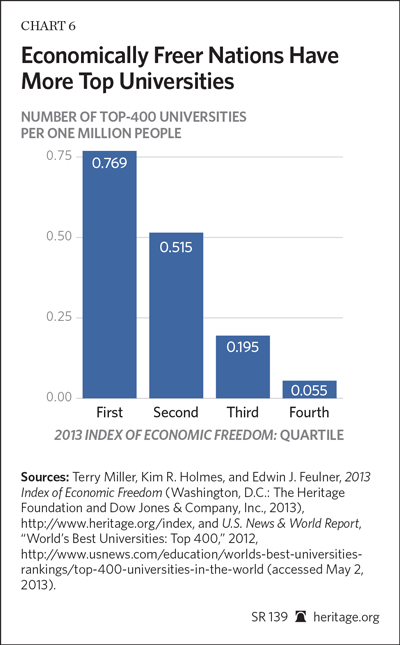
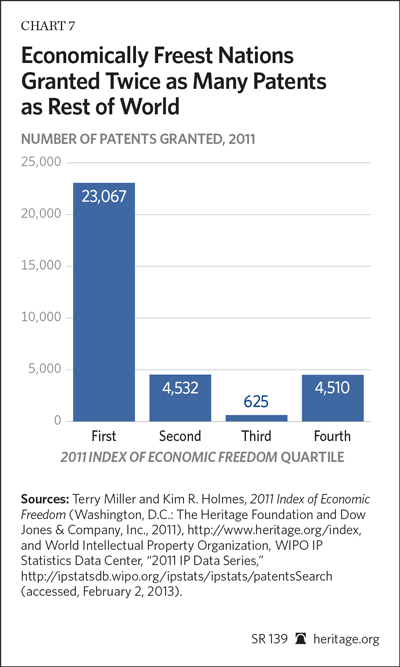
Broadly speaking, the best way to determine the quality of higher education in a country is by looking at the number of highly rated institutions. Each year, U.S. News & World Report ranks the 400 best institutions of higher education throughout the world by six categories: (1) academic reputation, (2) employer reputation, (3) faculty-student ratio, (4) international faculty, (5) international students, and (6) number of scholarly articles cited per faculty member.[13] When comparing the countries with the best universities in the world alongside the 2013 Index of Economic Freedom, a trend emerges. As demonstrated in Chart 6, countries in the first quartile of the Index, those with the most economic freedom, tend to have a higher number of universities in the top-400 rankings per million residents than those in the lower quartiles. In particular, the contrast between quartile one and quartile four is striking. Countries in quartile one have an average freedom score of 80.3, in the very upper bound of the “Mostly Free” countries. Consequently, these countries average 7.69 Top-400 universities per country per 10 million residents. Conversely, countries in quartile four have an average economic freedom score of just 56.3, and, not surprisingly, have far less than one Top-400 university per 10 million residents.
Another metric of a country’s human capital and ability to innovate is the number of patents granted each year. A country’s stock of patents gives an indication of how good its institutions are at breeding and training entrepreneurs, researchers, and innovators. Patents granted throughout the world are recorded by the U.N.’s World Intellectual Property Organization (WIPO). When patents granted in 2011 are compared to scores in the 2011 Index of Economic Freedom it becomes very clear that the freest countries in the world are overwhelmingly granted the most patents. Countries in the top quartile of the Index, the freest, are granted over 378,000 more patents than the next three quartiles combined. On average, countries in the top quartile of economic freedom, led by Japan and the United States, were granted 23,066 patents in 2011.[14]
Education Policies That Promote Economic Freedom. Statist policies that promote the centralization and bureaucratization of education systems lead to negative outcomes for students. Instead, policymakers should turn to ideas that embrace competition, choice, and localization. Among them:
- Promote school choice. Research demonstrates that school choice results in better educational outcomes. Districts that have implemented school choice policies record higher academic achievement through competition among schools, raising the achievement level among all schools in the district as they compete for voucher funds. Also, school choice correlates with safer educational environments.[15]
- Localize educational decisions. Local governments should have the right to spend money on education as they see fit, and decisions on local education should not be made by far-away bureaucrats. Local governments should reject national standards and testing, and curb centralized spending on education, empowering local leaders instead.[16]
- Reduce education bureaucracies. Drastic increases in government spending on education lead only to expanding administrative bureaucracies, not to better outcomes for students. Control of education should be returned to the local level, preventing funds meant for students from being filtered through huge education bureaucracies.[17]
Health Care
Of all social goods, health care has historically proved to be among the most difficult challenges for policymakers. Health care services are often costly, are sometimes distributed unevenly, and financial services such as private health insurance have sometimes been inefficiently regulated. In postwar Europe, modern society was built around vast welfare states with generous social safety nets and guaranteed health care for all citizens. Recently, policymakers (both elected and appointed) in the United States have expanded the federal government’s already intrusive reach into the health care market with the passage of the Patient Protection and Affordable Care Act, which dramatically increases taxes, expands Medicaid, and coerces individuals into purchasing health care through negative monetary incentives. These obtrusive policies will have questionable outcomes at best. Instead of creating massive, inefficient bureaucracies, policymakers must recognize that adhering to the principles of economic freedom is a much more effective way of distributing health care. Not only do countries with economic freedom have better health care outcomes for their citizens, but economic freedom also encourages the entrepreneurship and innovation that produces medical breakthroughs and new procedures that are vital for sustained technological progress.
Policymakers should let economic freedom policies lead the way for better health outcomes. By empowering individuals and letting them control their own insurance and health services, policymakers can return power to the consumers and put their health back in their hands. Instead of limiting choices and forcing families to purchase government-run health care, policymakers should encourage competition and choice as well as national private health plans that will spur innovation. By embracing these principles of economic freedom, governments throughout the world can help their citizens live longer, healthier lives.
From Birth to Death (But Not from Cradle to Grave!). At the most basic level, countries that embrace the principles of economic freedom have the means, and are more likely to provide, better health care overall from birth to death.
Infant mortality and life expectancy are two broad measures of health standards that give some indication of the ability of a society to provide good health care to its citizens. Low rates of infant mortality mean that women can afford to take care of their children throughout their pregnancy, and it indicates that good health care facilities are available to provide care during and after birth. Life expectancy is another broad and useful measurement of how well a country’s health care system performs. Longer life expectancies indicate that a country’s citizens are able to prolong their lives through access to higher quality health care for the young, middle-aged, and old.
Beginning life healthy and strong is vital for sustainable childhood and adolescent development. Infant mortality remains a huge challenge throughout the world, particularly in countries that do not embrace economic freedom principles. Low rates of infant mortality are correlated with higher levels of economic freedom (r=0.505). Most tragically, an additional 40 infants per 1,000 births die in the most economically repressed countries in the world (quartile four of the Index) versus the freest (quartile one). (See Chart 8.)
Regarding overall life expectancy, individuals who live in countries that fall into the highest quartile of economic freedom tend to live 14 years longer than those who live in the most economically repressed countries in the world. In addition, the relationship between economic freedom scores and life expectancy is positive. Analyzing U.N. data for life expectancy and the 2012 Index of Economic Freedom country scores, it is apparent that there is a strong correlation between economic freedom and life expectancy (r=0.56). This finding suggests that countries that follow the principles of economic freedom are not only better equipped with safe, sanitary, and effective medical facilities and environments for infants, but also enable adequate healthy nutrition, preventive medical care, safer communities, better access to clean water, and reduced levels of violence for individuals throughout their lives.
One barometer of better health is access to clean water, and to systems that quickly and efficiently remove waste products from living areas. Comparing data from the World Ban,[18] with the 2010 Index of Economic Freedom,[19] shows a correlation between countries with higher rates of economic freedom and countries that have a high percentage of people with access to cleaner water and improved sanitation (both at r=0.52).
In addition, there is also a clear trend towards better wastewater disposal services in countries with greater economic freedom. Although the sample size is smaller (51), data from the World Bank indicates that individuals in countries with higher levels of economic freedom have better access to wastewater disposal services. These indicators demonstrate that citizens of countries with high levels of economic freedom are able to afford such basics as indoor plumbing, potable water, and wastewater disposal and treatment. Such infrastructure prevents the spread of cholera and other diseases, and ensures that people have clean water for drinking and cooking in their homes. Overall, such facilities contribute to better health outcomes for society. By preventing the spread of diseases at their sources, countries can avoid negative health outcomes that often occur when people live near exposed raw sewage or must rely on unreliable water supplies. This ultimately reduces the lifetime costs of health care for each individual, increasing his or her yearly earnings and productivity by reducing costs and time lost due to sickness.
AIDS Prevalence. Over the past two decades a major area of focus for development and humanitarian assistance to the developing world has been to slow and reverse the spread of HIV/AIDS. Since 2003, the U.S. government and private partners, such as the Bill and Melinda Gates Foundation, have spent nearly $45 billion on AIDS relief to countries around the world through the President’s Emergency Plan for AIDS Relief (PEPFAR).[20] PEPFAR has been an important component in reducing the prevalence of AIDS, particularly on the African continent, because it is a focused program that began in the private sector and has been managed by agencies within the U.S. government—at the U.S. Department of State and the Centers for Disease Control—that are beyond the reach of the dysfunctional U.S. Agency for International Aid (USAID) bureaucracy.[21] Strategies to combat AIDS and other diseases, such as TB and malaria,[22] should focus on broader and more encompassing policies that will improve health outcomes through positive economic outcomes.
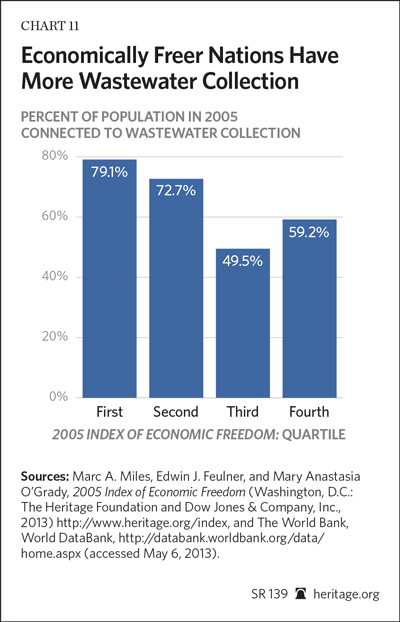
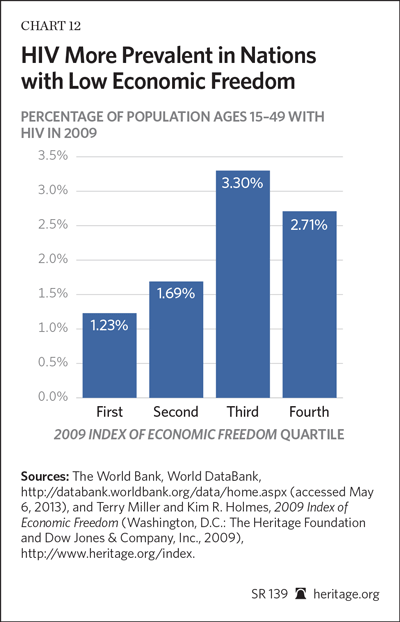
In particular, countries that enact policies based on the principles of economic freedom generally tend to have better outcomes for AIDS mortality and incidence. Using data from the U.N. on AIDS prevalence throughout the world and the 2009 Index of Economic Freedom,[23] it is clear that countries with higher economic freedom scores tend to have lower rates of HIV throughout their societies. Out of this sample, countries that ranked in the first quartile for economic freedom have considerably lower levels of HIV/AIDS prevalence. About 1.26 citizens per 100 in quartile one countries are living with AIDS, compared to 2.79 individuals per 100 in countries in quartile four, the countries with the lowest economic freedom scores.
Botswana is an example of the success of economic freedom in achieving health care outcomes. Botswana remains a major recipient of PEPFAR aid,[24] and its leadership has remained committed to the principles of economic freedom over the past two decades. This has resulted in higher scores in the Index of Economic Freedom, and a persistent downward trend in HIV infection.
These levels of economic freedom mean greater growth and wealth for the citizens in that country—and have permitted Botswana to allocate more money for the treatment of the relatively smaller number of AIDS patients. In 2002, Botswana was praised for proactively addressing the AIDS crisis in the country by implementing programs that distribute anti-retroviral drugs to patients.[25] As a result, HIV prevalence declined from a peak of 27 percent in 2001, to 23.7 percent in 2010. This has corresponded with a 23 percent rise in Botswana’s economic freedom score since 1995, making it the second-highest-ranked country in sub-Saharan Africa. (The highest-ranked country is Mauritius.)
Consequently, there has been little need for the sorts of wasteful and unfocused traditional development-assistance projects that swell the ranks of foreign aid bureaucracies at the U.N. and elsewhere around the world; HIV/AIDS projects in those agencies should be reconsidered.[26] Individual countries must take their destiny into their own hands. By managing their debt, creating impartial institutions, and fighting corruption, governments can spur the economic growth that will bring prosperity and wealth. HIV/AIDS is “a cause and an outcome of poverty.”[27] With economic freedom, countries can reduce the long-term prevalence of HIV, while programs such as PEPFAR target immediate crises.
Health Care Policies that Promote Economic Freedom. Instead of the coercive monopolization of health care through expensive and inefficient government programs, economic freedom can be applied to achieve positive health care outcomes. Government intervention and coercion in health care markets is far from the only, or most effective, way to achieve healthy societies. Instead, policymakers should:
- Eliminate Barriers. Policymakers can increase competition and choice by removing subsidies and repealing laws that prevent individuals from purchasing health care services from diverse private, market-based sources. Individuals should be allowed to purchase health care and insurance without the limits of geographic boundaries or employment status.[28]
- Encourage competition in government bidding. In systems where governments continue to play a large role in the health care system, policymakers should make sure that there is competition in the bidding process by private health care providers. Competition among bidders helps to reduce cost and encourages innovation.[29]
- Encourage insurance regulation at local and regional levels. Top down, one-size-fits-all regulation ignores local differences in health care and insurance markets, reducing innovation and undermining choice. Policymakers should instead focus on decentralizing regulations, allowing rules to fit the customers.[30]
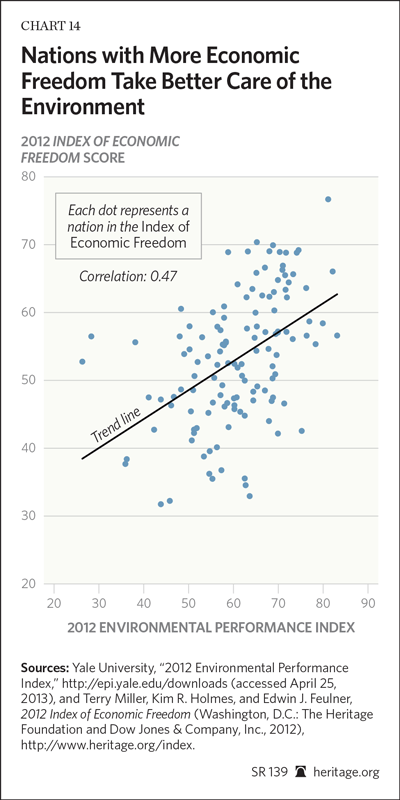
The Environment
Apart from health care, no other government policies and actions have been more intrusive and economically distortionary than environmental ones. Rather than relying on the self-interest of property owners, the market, and a free press to ensure environmental quality and safeguards, a myriad of government bureaucrats and agencies are attempting to regulate the water people drink, the air they breathe, and the food they consume. Some governments have proposed programs to tax carbon emissions and increase taxes on gasoline, set up non-transparent and economically harmful exchanges and marketplaces for the buying and selling of carbon emissions, and have created subsidies for “clean” energy. Such policies impose a huge cost on society. They also retard economic growth.
Critics of the free market sometimes complain that environmental degradation is the result of “market failure,” whereby negative externalities are created through the private sector’s production of goods and services for which individuals and firms are not held accountable. Thus they defend the necessity of imposing government regulations to control these negative externalities. But their arguments are hollow: Economically freer countries throughout the world continue to outperform their repressed counterparts on environmental protection. Economic freedom, and the wealth that flows from it, is wholly consistent with, and supportive of, a healthy environment. The environment is also better protected when larger percentages of land and other real property are privately held and protected by a country’s judicial system. Coercive government action to regulate the environment threatens the very means by which economically free countries have been able to clean up their environments in the first place.
Economic Freedom and Environmental Protection. Statists and environmental extremists often argue that proponents of economic freedom have little interest in protecting the environment—that economic freedom harms the environment because it encourages pollution and environmental degradation. This claim is false. The principles of economic freedom are a better means to the same end.
Yale University’s Environmental Performance Index (EPI) is a credible metric for assessing the environmental health of a country. The EPI measures two broad categories of environmental performance: environmental health (the effects of air and water on human health); and ecosystem vitality (including various sub-metrics, such as biodiversity, climate change, and agriculture). When the results of the EPI are compared to the 2012 Index of Economic Freedom, a significant positive trend emerges (r=0.47). This trend indicates that as countries move from economic repression to economic freedom, their environments improve as well.
This trend is also telling in a historical comparison of the Index of Economic Freedom and the EPI. Dating back to 2000 when Yale released the first EPI, there is a marked relationship between the movement of the EPI and the movement of countries’ scores in the Index of Economic Freedom. As the worldwide average of economic freedom began to slow down in 2008 so did the EPI.[31] Since then, both indices have stagnated.
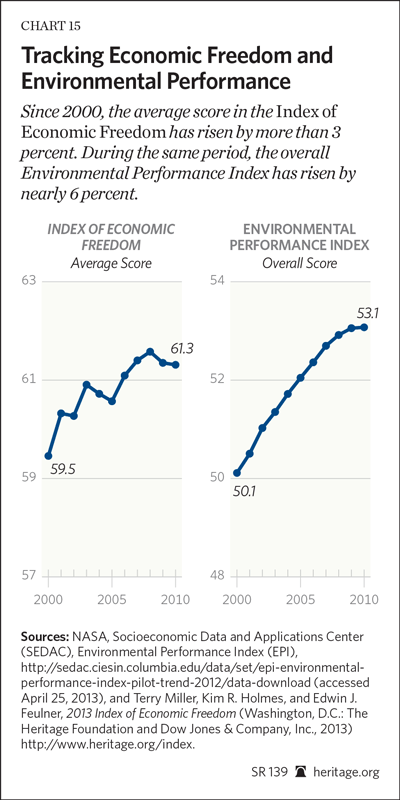
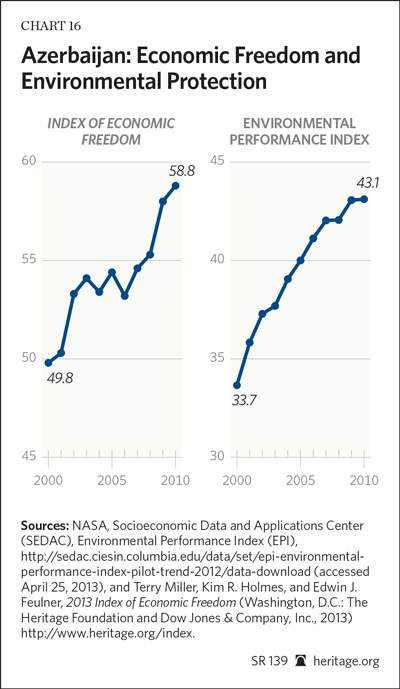
Not surprisingly, the countries registering the most significant advances in environmental protection often also enjoy the biggest improvements in their economic freedom scores. Azerbaijan is a prime example. Since 2000, Azerbaijan has reformed its economy and cleaned up its environment, embracing the principles of economic freedom and improving its EPI score at the same time. In the 2000 Environmental Protection Index, Azerbaijan scored 33.7, 128th in the world—near the bottom. Since then, Azerbaijan’s score has improved by 28 percent, lifting the country to a score of 43.1, 17 spots higher in the EPI rankings. At the same time, the Azerbaijani government began to embrace economic freedom—opening its borders to trade, making some reforms to its tax code, and lightening the overall regulatory environment on the economy. As a result, since 2000 Azerbaijan has raised its economic freedom score from 49.8 to 58.8, a nearly 20 percent improvement. This rise has lifted the country 36 spots in the Index rankings since 2000.
Taking Ownership of Environmental Protection. To the extent that it ever was, the basis for current environmental policies in many countries is no longer economic freedom. These policies are based, instead, on an embrace of subsidies to “green” companies and regulation of industries that are deemed “dirty.” In practice, the implementation of these policies has created too many opportunities for cronyist, big government–designed and big government–subsidized monopoly rents.
To reverse this trend, policymakers must return to the principles of economic freedom, with private property rights as their backbone. Protecting private property is a cornerstone to protecting the environment. A comparison of property rights in the 2012 Index of Economic Freedom and 2012 EPI shows that the relationship between strong property rights protection regimes and healthy environments is even greater than the broadly positive relationship between economic freedom and clean environments. In this analysis the positive correlation between property rights and environmental protection is very obvious (r=0.6), indicating that countries with good private property protections have cleaner environments.
This association should not be surprising. Using private property as a tool for conservation and resource management works because it “empowers owners to act as stewards of environmental resources and facilitates conservation efforts in the private sector.”[32] The concept behind this is simple. Because land values usually increase over time, owners have an incentive to maintain the quality of the land and its improvements in order to preserve its value. Owners of private property have no interest in destroying the value of the land or its environmental qualities, because they would not profit from such degradation.[33] For example if timber producers are allowed to own and exploit the resources of their land for timber production, they will have the incentive to maintain that land, and replant the trees as they fall (or are harvested). Without investing in sustainable timber production, these companies would be left without timber to use, and would be paying property taxes on unproductive land.
These same concepts can be applied to fisheries management. In the 1990s, Iceland implemented Individual Transferable Quotas (ITQ) for fishermen—a quasi-private-property system for fisheries. These quotas gave exclusive individual rights to fishermen to “harvest specific portions of the overall quota of marine fish”[34] and allowed them to transfer these rights—like private property—to others. This gave more efficient producers the opportuntiy to buy out less efficient ones. While efficiency improved, the ITQ system also contributed to the gradual improvement of fish stocks in Icelandic waters, consequently improving environmental sustainablity.[35]
Promoting a Clean Environment Through Economic Freedom. Claims that economic freedom and environmentalism are mutually exclusive are not supported by the data. Policies that promote and rely on higher environment-related taxes raise costs, limit freedom, and can actually increase environmental degradation. Instead, policymakers should embrace economic freedom and environmental protection by:
- Respecting Property Rights. Policymakers on the Left often disregard individual property rights in their implementation of coercive environmental regulations. Respect for property rights should be at the forefront of any environmental policy. Landowners should be fairly compensated for any regulatory takings that are based on environmental regulations.[36]
- Removing wasteful subsidies for “green energy.” Industrial policies that seek to pick winners and losers, choosing one sector over another, are always ultimately counterproductive and end by encouraging malinvestment. Instead, policymakers should allow the market to decide where best to allocate resources for energy generation. Market decisions to switch from coal to natural gas (coupled with private sector–led advances in drilling technology), for example, have been a significant contributing factor in declining CO2 emissions in the United States.[37]
Conclusion
This Special Report has attempted to expose the fallacy that economic freedom principles undermine the provision of social goods. In fact, the principles of economic freedom have shown themselves to be more efficient and effective than statist approaches for the provision of those goods.
Those on the Right and on the Left want the same better outcomes for themselves and their children: good education, access to better health care, and cleaner and safer environments. The differences lie in their approaches and the designs of policies. “Progressive” policies meant to achieve these aims are generally ineffective, inefficient, and financially unsustainable.
It is the principles of economic freedom—free markets, rule of law, protection of private property, and open trade—that boost prosperity and reduce costs so that societies can protect their environments, improve health, and broaden access to education. Nineteenth-century neoclassical economist Alfred Marshall witnessed the prosperity that free markets brought to England during the early days of the Industrial Revolution. Marshall said, “The hope that poverty and ignorance may gradually be extinguished, derives indeed much support from the steady progress of the working classes.”[38] It is that progress that the world needed then, and continues to need today. The hope and promise of the free market generates more progress than progressivism ever has.
About the Authors
James M. Roberts is Research Fellow for Economic Freedom and Growth in the Center for International Trade and Economics (CITE) at The Heritage Foundation. Ryan Olson is Research Assistant in the Center for International Trade and Economics. CITE interns Drew Ringley and Ashlee Smith contributed to this paper. How Economic Freedom Promotes Better Health Care, Education, and Environmental Quality James M. Roberts and Ryan Olson
